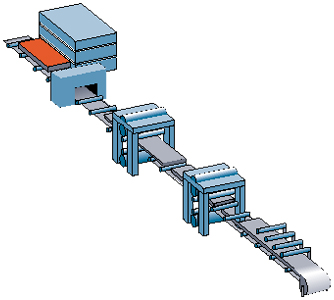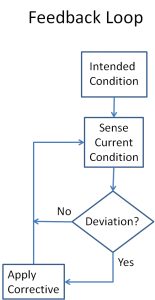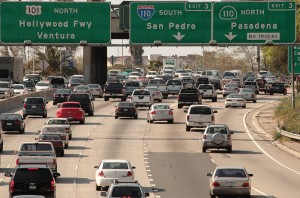TEA FOR TWO
Two young Chinese ladies, performing for passers-by, hold the handles of their teapots two arm-lengths away from teacups and unerringly fill them without spilling a drop. The crowd is amazed. How did they do this? How could they control the tea so well as it was being poured?
Answer: by using a control strategy that is at the root of controlling nearly all processes.
Look at the ladies’ eyes in the photo. They’re not looking at the spout from which the tea is being poured. Actually, they’re not even looking at the rim of the cup being filled. They’re looking at just one point: the center of the rim’s circle.
If they see any deviation from that point in the stream of tea, they make a slight adjustment to return the stream to the center. And they keep doing that until the cup is filled.
All other information (angle of the spout, position of the nozzle, distance from the cup, where their arm is, size of the cup, etc.) is not only irrelevant to controlling the flow, it tends to divert their attention from their aiming point (with unhappy results for the tablecloth).
Yes, the design of the teapot helps. The spout gives a very straight and narrow stream, and its length brings the nozzle nearer the teacup as well. But these are only implementation enhancements. The essential reason for the pouring accuracy is the underlying control strategy that’s at work here. It’s also at work in processes going on all around us.
How do you roll?
Here’s an example. Sheet metal is used in the stand of the computer display I’m using as I write this. It’s also used in the cover and body of my laptop, external disk drives, whiteboard, stovetop, car body, microwave, espresso machine, TV, stereo amp, shovels, trash can, … you get the point. This useful, affordable material is made in many, many steel plants, aluminum plants, etc., throughout the world, as a matter of course. But it wasn’t always that way.
The basic economical approach to making the sheet is simple: start with a red-hot ingot, and run the material through a succession of rollers that squeeze it down to the desired thickness, as indicated in the drawing.
But making it used to be an expensive and big deal, because it was so hard to control the thickness of the end product. All kinds of factors could affect that thickness: initial temperature of the ingot, temperature change through the process, traction to move the metal through the rollers, precise starting thickness, precise roller pressure at different stages to thin out the material, slag and other surface contaminants, roller wear, etc.
All these and other factors had to somehow be precisely controlled to result in a useful sheet of predictable, uniform thickness. Maintaining control over the many interacting factors was a very complex, expensive and rather unreliable exercise. PhD mechanical engineers wrote their doctoral theses on the subject and became experts in the specialty. Plant managers tore their hair out. What to do?
Eyes on the prize
Along came a guy named Norbert Wiener. He was pretty smart (PhD in math from Harvard at age 17 yrs). And he had an interest in control starting from his days working ballistic gunnery tables for the Army during WWI and later working on the problem of automatic aiming and firing of guns during WWII.
So as a math professor at MIT, he took up the problem of automatic control. In his general solution, he was able to cut through all the complexity and, like the tea-pouring ladies, control an entire process by monitoring and adjusting just one essential factor.
The steel industry jumped all over this discovery. For rolling mills, the key factor turned out to be traction. All that was required was to measure the thickness of the sheet at a point in the process, and adjust the traction with which the sheet was being pulled accordingly.
With a small electronic box connected to the existing milling equipment for the purpose, out came, at long, long last, sheet steel that was of uniform correct thickness, and was affordable. New ball game for the industry.
But Wiener’s solution provided a general theory of control applicable to nearly any kind of process.* At the center of his approach was the truly elegant closed feedback loop. Check it out in the diagram to the left.
The loop is started by establishing some intended condition such as tea stream at the center of the cup rim, or metal sheet 3.2 mm thick. From then on, it’s just a matter of repetitively checking the current condition against the intended one, and making a correction if necessary. It could hardly be simpler.
And that’s the very good news here. As with the rolling mill, we can recognize many factors that can affect any process. But we don’t have to jump in and try to control all the factors to control the process. We need only manipulate a key factor to obviate all the others and get the result we want. Ignore the rest. In this case, ignorance is bliss.
Feedback loops abounding
A close look makes it clear that there are vast numbers of these loops inside us and outside, just looping away, keeping the living and civilized worlds under control.
Let’s go for a road trip. You pack your bags, hop in the car and head out for Yellowstone NP. You have long distances of good road to cover and decide to use the automatic cruise control system of your car. You set your speed to 78 miles/hr (arguably 75 in a court of law), sit back, and let the cruise control mechanism take over control of your car’s speed.
Cruise control constantly checks your road speed against your intended 78 mph. If it detects that your road speed is dropping below 78, it increases your engine speed as a corrective and checks again. If road speed is still too low, it adds even more engine speed.
If you’re going too fast, it reduces engine speed. If you’re going 78 mph, cruise control takes no action at all and just checks your speed again. And so it continues as long as cruise control is turned on. The feedback loop is automatic.
Meanwhile, you’re steering the car. Various factors affect the car’s direction relative to the road. Wind, curves in the road, slope of the road’s crown, etc. You constantly almost unconsciously check to see if the car is pointing parallel to the road’s center line.
If it’s drifting away from the center, you correct a little to the left and check again; if drifting to the left, you correct to the right and recheck. You continue this way ‘til you’re at your destination. Here the feedback loop is manual, and you’re part of it.
Again meanwhile, the outside temperature is changing as your drive through the prairie and the mountains, and the temp inside the car follows. You have your own thermostatic feedback control. If you get sufficiently hot, you perspire, and get your temp back where it belongs through evaporative cooling. If you get too cold, your body applies the corrective of shivering, causing your muscles to heat up through a lot of contraction. Automatic feedback loop in operation.
Of course you could intervene with manual control by adjusting your car heater and A/C from time to time yourself, when the temp drifted from what you wanted. Still a feedback loop.
It’s a long drive. And you happen to have the Epstein-Barr syndrome. When you’re driving too hard and long, the virus cuts in, fatiguing you. When you back off for the day and stop driving early because of it, the virus backs off, which gives you more energy. With more energy the next morning, you go back to over-working and the virus cuts in again. And so on. So your driving time is constrained by a feedback loop in the syndrome.
Time for a snack. As you devour that Snickers Bar, feedback loops controlling the metabolisms of millions of bacteria in your gut enable the digestion of your food.
Even more meanwhile, other loops are spinning along. Your GPS is testing satellite signal strength and acquiring satellite signals as necessary to keep the signal strength where it needs to be (as well as the min. number needed for triangulation), your engine coolant is being checked and radiator fans are being activated/deactivated to keep coolant temp in range, etc, etc.
And while you’re on this trip, the nation’s economy procedes at its pace. The economy is notoriously complex, with many marginally predictable interacting factors affecting its health. But inflation rate is a key governing factor.
For a growing economy, inflation up to 2% is usually acceptable for economic health, and it’s periodically reviewed very carefully by the Fed. Over the 2%, and the price increases depress sales of goods & services, and the economy begins to falter. If that happens, or it appears that it soon will, the Fed applies the corrective of increasing the interest rate, which brings the inflation rate back in line into the intended range. Feedback loop.
As you drive past trees and animals, you’re driving past the many feedback loops maintaining internal parameters that are actively keeping all these organisms alive.
In the Strategy Facts of Life post that initiated this blog, I tried to convey how completely immersed we are in a soup of strategies. As we can see from this current post, many of those are control strategies with feedback loops that are humming away all around us, at the cellular level all the way to the planetary level. Life and civilization at work, right?
How to devise a control strategy
Since we frequently find ourselves in need of a strategy to keep things under control and make them turn out to our liking, knowing how to easily devise a control strategy is a fine thing. And it’s easy.
The reason its easy is that control strategies, as we now know, are generally built around a feedback loop, and that it only takes a single factor to control that loop.
Let’s do it. Let’s devise a strategy – a control strategy. Suppose we’re in, say, L.A. and have two cars full (car fulls?) of people that want to travel north to, say, Sequoia National Forest. People in the lead car know the way. People in the 2nd car don’t. We’ll have to deal with lots traffic lights, other cars cutting in and intervening between our two during freeway madness, turns, etc. Let’s devise a strategy that ensures that the 2ndcar full of people doesn’t get left behind and lost.
We need a good feedback loop, right? We fish around in our heads and recognize that a key factor is how far the 2nd car is from the 1st one. If it falls too far back, trouble follows. If it stays close enough, we’re in control.
No surprise, it can work like this: just watch the rear-view mirror in car 1. If car 2 is getting smaller, adjust relative speed by slowing down (only one factor to control). Keep doing this until car 2 appears sufficiently large. In the event car 2 has to stop, say for a traffic light, car 1 pulls over and waits until car 2 resumes. Keep doing this until you get to your destination. It doesn’t matter how much traffic there is, what anyone’s speed is, that there’s an accident in the left lane, etc. This is all you need to do to make sure the 2nd car doesn’t get lost in traffic.
Complex control
So we can readily devise a strategy to manage something simple in a complex environment. But what if we want to manage something more complex? As situations become more complicated, more simple loops can be added.
Suppose instead of 2, we have 8 cars full of people – looking at the picture above, how in the world do we keep this caravan together? The very same way.
In all cases a car ahead of another car is responsible for keeping it in sight and slowing down or even stopping if the one behind becomes too small in the mirror. So car 6 will slow if car 7 slows. This in turn will cause car 5 to slow, which will cause car 4 to slow, which will cause …, etc, and the caravan remains intact. The only other rule is that a car behind can’t pass one in front of it.
All we’ve done is create a chain of simple independent feedback loops, and we can then easily and automatically deal with the seemingly impossible task of taking a large caravan of cars through the messy vagaries of L.A. traffic and keep it intact.**
Control strategy wins again – thanks to the closed feedback loop and a rear-view mirror.
____________________________________________________________
* There are other kinds of control, too. In some, no feedback is required (e.g. in controlling your dog with a leash). And there is also the open feedback loop, in addition to the closed one we’ve been looking at. Open loop is used for control only in very rare, specialized circumstances. Open loops usually result in the opposite of control and are self-amplifying. A Tweet going viral is open loop, as is a cattle stampede.
** By the way, this caravan example isn’t an abstract exercise. Some friends in L.A. came up with the strategy, have ocasion to use it quite often, and have refined it further than what’s described here.
Readers are encouraged to add comments to this post.
And if you’d like to share or recommend the post, click on your preferred way in the left margin sidebar.
Stay tuned for the next post. It’s about how to defeat control strategies that are unfavorable to us.
If you’re not currently being automatically notified when new posts are published, then please Follow Real Strategy (top of right hand column on this page), and indicate how you’d prefer to be notified.
For other posts of interest, look in the Smart Menu.
Further reading: I recommend Out of Control by Kevin Kelly; interesting perspectives on the past, present and future of control.
Photo credit: Pouring Tea, China Connection Tours, China Tour Link
Photo credit, Rolling Mill, Hong Ji Group, http://www.hsnee.com/rolling_mill.htm
Photo credit, L.A. Freeway, http://commons.wikimedia.org/wiki/File%3ALA_freeway_2009.jpg










The feedback loop that comes to my mind is another more “animated” sort of caravan, that of a camel caravan. As I recall, camel caravans frequently travel at night and audible camel bells are a necessity. To some extent, it is my impression, camels do care about herding (even as cat’s don’t). The camels go along to get along.
Herding is a remarkable example of a feedback loop; and when one contemplates the apparently immediate reaction within a flock or birds or on the wing, the schooling of fish or even a scattering group of African antilope, one sees a feedback loop. I think we all may have observed the confused lion, uncertain which animal to pursue.
Do people herd together as well? Some say that this sort of human behavior is to our detriment. And yet, if we don’t check on information coming from others in a certain group, chaos can be the result.
[Translate]
Great example, Bill. Especially in a linear situation, Individuals looking after those behind them is also about consciousness, that is, each minding those behind via each in the caravan as a whole.
We often hear about “Democratic strategists”, and “Republican strategists”, sometimes interviewed during election season.
On your next post, “how to defeat control strategies, ” could one do something as complex and as exasperating as defeating the US republican strategy of obstructionism? or is this particular model just for things that are more linear and mechanical?
[Translate]
The next post will address defeating control strategies, incl. adversarial control strategies (see comment to your comment, below). But this means defeating strategies that include feedback loops, which aren’t generally what you’re referring to.
Defeating committed obstructionist strategies is really difficult. A primary way is to make obstruction not worthwhile to the obstructionist (i.e. reduce the value of their objective). For example, make enough of their constiuents perceive the negative impact of the obstruction that they punish the obstructionists for it (say by not electing them).
But one of the objectives of the obstruction is to lower voter satisfaction with the current administration and make it less electable.
At this point it’s unclear which way it will all play out. But we’ll know soon enough.
[Translate]
In your caravan consciousness strategy example, all of the people in the caravan want to get to the destination.
When we are talking about manufacturing steal, the relatively linear process of feedback loops that give a certain end result, it is easy to see.
Is there any way to create strategies for nonlinear conditions and even those where, in human terms, there are several competing strategies in play and a certain amount of chaos and intrigue? My guess is it would involve many internal strategies to accomplish clear results when working with non-cooperative social settings.
[Translate]
All adversarial situations, friendly and unfriendly, involve strategies that are non-linear in the sense you mean. Non-linear because an adversary is adapting to and meddling with your strategy by some combination of creating new or greater barriers for you, removing weaknesses in those barriers, diminishing your resources and advantages and/or throwing a wrench into how you’re exploiting your advantges. They’re also beefing up their own strategy. And you’re probably doing the same unto them.
So here the complexity comes from an adaptive adversary, who’s frequently changing your situation. For me, this is the most interesting strategy situation, because, while rolling mills and L.A. traffic certainly have their complexities, there’s no intelligence behind them, trying to play with your mind; no battle of wits.
[Translate]